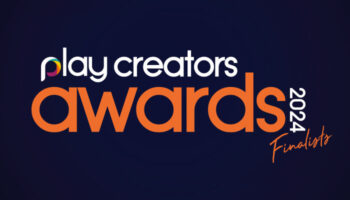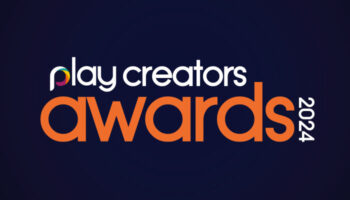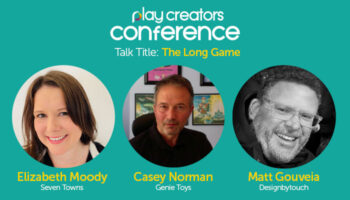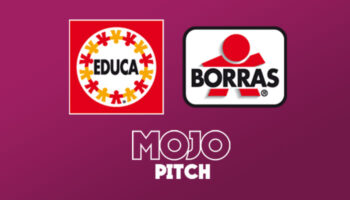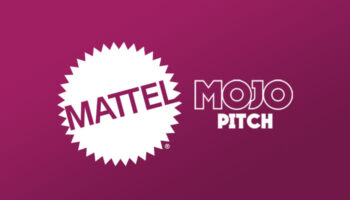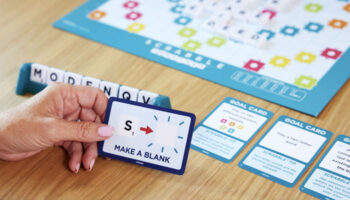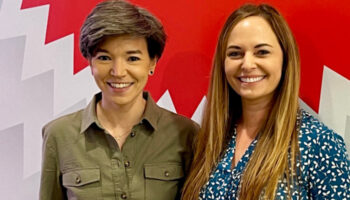Why the worst proof of concept is better than the best drawing: Make It Real’s Isaac Wolman explains all

What a delight to see you! Thanks for making time, Isaac. So… You’re the entrepreneur that founded Make It Real. But how did you come to do that?
I started off as a distributor in the United States and then ended up working as US Sales Director for a company called Wooky Entertainment, based in Montreal.
May I just check… When was this? And did you say it was called Wooky?
W-O-O-K-Y. Yes, like the space bear but with a Y.
Oh, “like the space bear”! I’ve not heard it called that, but I like it.
And as to when this was… Well, Wooky went out of business in 2016, and my wife Sarah and I started Make It Real in 2017. We’ve been in business now for… Well, we count in Christmas years so this is our sixth Christmas.
Only six? You’re growing well and growing fast…
Thank you. We’re also having fun doing it!
I don’t think I saw anything by Wooky… Did they work in much the same areas as you do now?
Yes, similar type product, but when we founded Make It Real, we did it with a bit of a mission…
Well, I wanted to ask about that. The company says it’s on a mission to celebrate play, ignite creativity, and inspire imagination!
Exactly. In the toy business, we have a unique opportunity. We get to put millions of toys into the hands of kids around the world. And almost any girl who grows up and becomes a creative in whatever field can point to a toy that that inspired them as a kid – whether it was their favourite toy, a doll or some sort of fashion something or other.

Right…
So, as companies, we’re in a unique position: we get to have a hand in inspiring the next creative generation. When we created Make It Real, it was really with that ethos in mind. We asked ourselves: “How can we create beautiful, meaningful products that also have a story behind them?” You know? We wanted products that would give girls a world of inspiration.
And you focus exclusively on girls, don’t you?
We do. And when we started, we actually took on a number of women who had jobs in creative fields, and they did interviews. You can still find those on our website, and we included them in our packaging. Just to give girls that connection, like: “You’re doing a fashion sketchbook now, but guess what? There are 30 and 35-year-old women who are also using fashion sketchbooks –they’re designers for Bloomingdale’s and Nordstrom, and major clothing companies.
The girls of today can connect their play to the real world?
Exactly. Here’s yours… Here’s what theirs look like… And here’s the difference between yours and theirs. That was the dream.
So nearly six Christmases on, Make It Real has a great reputation in the industry, but – for people that don’t know your products – what kind of things do you make?
We design and manufacture activities, accessories and lifestyle products for tween girls. Our design ethos is to try and do everything beautifully… The components are beautiful, the product is beautiful – because, by doing that, it’s really aspirational; it gives kids that amazing feeling: they build something, they want to use it or wear it. It’s not just 50,000 plastic beads in a tub which they’re never going to look at again.
Ha! 50,000 plastic beads in a tub! And how do you do it? How do you make sure it’s also beautiful?
We have an amazing innovation team. We’re trying to design unique products. We’re trying to design things that are going to inspire, and wow… Creating that magic moment for girls is literally what we live for. That’s our DNA.
And this might be a thorny issue, but I’m curious: how do you feel about the notion that there should be no distinction between toys for girls and toys for boys?
I don’t have any issues… If there was a demand – a real demand – for our product among boys, I’d love to be able to make it. I’d even make our product unisex in as much as we possibly could.

But that demand isn’t there?
I think activities in general find significantly more demand in the girl’s space and fundamentally, I think, the first rule of any business is that you have to survive… So we have to accept that products these days have less and less space on shelf, and that business is more and more competitive…
Right. Which is maybe why some online sellers and real-world boutiques feel confident that the demand is there… Their success in a niche creates the illusion of a huge market… But that’s not your experience?
No. And having spoken to a lot of other merchants in our space – by which I mean activity product: jewellery-making, cosmetics, things like that – there is no actual real demand from boys for our products; not in a meaningful way. Boys don’t go to that aisle to look for those products. If we were designing products for that demographic, we’d ultimately be designing products for a demographic that isn’t interested in purchasing them.
I think your response is very pragmatic. But if I can prove to you there’s a real demand for the product…
If you can show me there’s a demand for the product, or there’s a meaningful demand for unisex packaging on the type of jewellery that we make, or if there’s somehow a demand for male cosmetic items, for eight- and nine-year-old boys, then God bless!
That’s a very reasonable answer actually. If you thought there really was money there, why would you ignore that market?!
Right!
That’s really interesting; I’m glad I asked. And going back to your mission, does having that – and having your values – make it easier to develop a product? Or make it harder?
It makes it harder! Much harder, because we rank all of our products based on, I would say, a set of probably 15 different criteria. But ultimately, in order for a product to go forward it has to be viable commercially, from a sales perspective. It can’t JUST be a brilliant idea and a beautiful design. It has to be something that girls are going to love, and want to buy more of; or more of something similar.

Absolutely.
And if you look at the way we develop our product – even with Disney – we’ve often created our own imagery, our own designs and our own style guides to suit. With Juicy Couture, we created our own style guide. Same with Hello Kitty: we’ve created our own style guide because we’re so passionate about being unique and special; being different and not brandslapping. Our ethos really informs how we do all our development.
And that also informs how you choose which licenses to work with, presumably?
Correct.
But what’s the criteria there? How would you know a good license from a bad license?
That’s a really, really good question. There are some licenses which are evergreen, which on some level you have a baseline confidence that you’ll be able to do something… Things like Disney and Sanrio. Other times, the biggest wins in licensing are the ones that nobody saw coming. But those you have to bet on!
Can you give an example of that?
We just came back from Vegas. We met with a lot of people and saw a lot of things that nobody’s seen yet. You just have to bet on what’s going to take – and often, you have no idea. So for example, nobody knew that the first Frozen was going to be what it was. Nobody knew that Encanto was going to be what it was… That’s why there was so little product out there when those movies launched.
And are there examples of it the other way round? It not paying off so well?
Licensing is one of these really, really challenging, knotty spaces. You have to make bets, and you want to be unique, and you want to be different. You want to be in a space where not everybody is, but you also have to hope that the property really takes off.

Wow. Good answer. It sounds to me like there’s a knack to it – that you sort of say, “Well, I could be completely wrong, but I feel this would work.” But after that knackiness – and I may have just invented that word – after the knackiness, you’ve got a bit of a gamble. You’ve got both – it’s a treacherous industry!
100%. You’ve got it!
Are there any opportunities in licensing, then, that you’d like to explore but haven’t got round to yet?
I’d say we’re very blessed. As you said before, we’re lucky in that we have a good reputation in the industry. When it comes to working with inventors, and licensors, we have a lot of opportunities. For us, it’s really just – in this industry – a case of understanding that the real cost of doing something is not actually doing it…
Meaning what?
Meaning that developing an idea, or paying a minimum guarantee, isn’t the real cost of doing a product. The real cost is the ‘opportunity cost’ of not doing something else.
Oh, I see! It’s what’s hidden in the negative space…
Right. Sometimes it’s in your own brand, sometimes it’s in a license. But from our perspective, we’re blessed with a lot of opportunity. The biggest challenge is how to narrow it down to ensure we’re maintaining the right balance as a brand: not overdoing one thing and – by definition – underdoing something else.

Great answer! I love that; that was great. And you mentioned inventors there… If I were an external inventor, and I was pitching to your team for the first time, what advice do you think I should keep at the back of my mind?
I think the first thing that’s really important is identifying products that are unique. One very frustrating thing is that we’ll often get decks from inventors with products that are dramatically similar to other things that are on the market. They really look just like them with very, very minor changes… And of course, the inventor’s asking for minimum guarantees and royalties on a product which is, essentially, out there already. So innovation and differentiation are important.
Innovation and differentiation… Anything else?
I think, also, I’d say that if you’ve taken the time and gone far enough along that you’ve already built a working prototype, it gives us a lot of confidence that you’re serious and that it’s something which is actionable. As opposed to spending $250 on somebody to draw something, then effectively saying, “All right, you guys go spend the money and and actualise this…” That’s where we struggle, even if we love the idea. We don’t know if it’s going to work, but we do know it’s going to take us three months to determine whether or not it’s viable. Then we’re going to have to pay an inventor for the privilege of determining whether or not it works.
Ideally, then, inventors will bring you something much more substantial?
Yes. Fi Murray’s a great example of that. Whenever she comes to us with something, she’s already got a breadboard. She’s got something, she knows how it works; she’s got a video made. She knows and we know that it’s a prototype – it’s not perfect and it’s not the end result, and that we’re not going to manufacture exactly that… But we’re always confident her ideas are going to work because she’s already proved it.
She’s – yes, she’s done the legwork; she’s proved it with a working example…
Right. And if we like the idea, she’ll send us the example three days later. That just gives us so much confidence that – whenever we meet with her – we’re going to be getting things which are different, practical, workable, actionable, and on time. That is huge for us.

Wonderful! I’m going to repeat that because that’s the world on a string… Inventors need to show your team that they can produce different, practical, workable, actionable ideas – and on time… It also sounds to me like you’re saying the worst proof of concept is better than the best drawing…
Exactly. Exactly that.
Well, Isaac… This is been a real pleasure. We do need to wrap it up, but I also want to speak with you about The Make It Real Foundation… It sounds extraordinary. If we wrap this up now, will you come back and talk to us about that?
I’d love to!
In which case, let’s finish this up with one final question… Actually, looking behind you… This may not be relevant. Are you in – is that your office?
Yes…
It’s not a meeting room?
No, this is my office.
But there’s nothing there, Isaac! It’s the sparsest office I’ve ever seen!
Yes, I do keep it pretty sparse!
Well, I was going to ask: “What’s the most interesting object in your office or on your desk?” but…
There’s nothing here!
There’s literally nothing! I see only the desk. You, a chair and one desk…
Well, you can’t see this, look… Let me show you. I’m going to say this is the most interesting thing…
It’s the only thing!
It’s the only thing, which makes it the most interesting!
Well, I can’t argue with that! Let me change the question: Isaac, what’s the only object in your office?
The only object in my office is my new podcast mike. I’ve just started doing podcasts!
Okay! That’s the answer! Thank you, Isaac; let’s tie in again soon.

–
To stay in the loop with the latest news, interviews and features from the world of toy and game design, sign up to our weekly newsletter here





